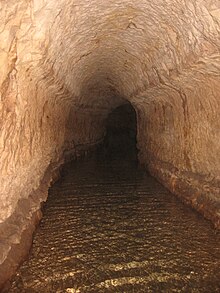Gadara Aqueduct
The Gadara Aqueduct (Qanat Fir'aun) was a Roman long-distance water pipeline system for supplying the Decapolis cities of Adraha in today's Syria, as well as Abila and Gadara in today's Jordan . The system was about 155 km long in total. It began near today's Syrian city of Dilli and ran above ground in the first part. The section which is in present-day Jordan was largely underground (total 106 km) in the Qanat built construction method from about 2900 up to 70 m deep Bauschächten and is considered the longest tunnel in the ancient times . After a 25 km long section could not go into operation due to surveying or construction errors, the first c. The Turab aqueduct, which was built 30 km in length and was also underground, was integrated into the system in order to deliver the water to Gadara in this way. The water came from large springs and a Roman dam in southern Syria. The system, which was probably started in the 1st century AD and largely completed in the 2nd century, was probably in operation for more than 400 years, parts of it until the 12th century. The aqueduct was built from 2004 by Mathias Döring scientifically researched by the University of Darmstadt.
Detailed information on the structures, bridges and locations on and around the aqueduct
In the course of more than ten years of research in the project, which was also funded by the DFG, numerous previously unknown structures were found. Individual sections of the aqueduct route could be put into a common context by means of high-precision GPS measurements. Countless reports from travelers in the 18th and 19th centuries were also helpful here. The first European was UJ Seetzen who saw parts of the aqueduct route in 1805.
literature
- Mathias Döring: Roman Water Systems in Northern Jordan. In: Proceedings of the 12th International Congress on the History of Water Management and Hydraulic Engineering in the Mediterranean Region. Ephesus 2004. Austrian Archaeological Institute, special publications. Vol. 42. Leuven / Vienna 2006, pp. 237–243. ISSN 1012-5728
- Mathias Döring: The longest tunnel in the ancient world. In: Antike Welt , 2/2009, pp. 26–34.
- Mathias Döring: Water for the Decapolis - Jordanian mountainous country has the longest known aqueduct tunnel to date. An interim report. In: German Archaeological Institute: People-Cultures-Traditions Vol. 5/2012: Water management innovations in an archaeological context, 225–243. ike.
- Mathias Döring: Water for the Decapolis - Roman long-distance water pipeline in Syria and Jordan . Writings of the German Water History Society DWhG, Vol. S 12, 292 S., Siegburg 2016. ISBN 978-3-9815362-3-2 .
- Mathias Döring: Qanat Fir'aun. An Underground Roman Water System in Syria and Jordan . Underground Aqueducts Handbook. New York 2017, pp. 173-196. ISBN 978-1-4987-4830-8 .
Web links
- Gadara Aqueduct on romanaqueducts.info
- Matthias Schulz: The channel of the pharaohs . In: Spiegel Online . March 9, 2009.
- Map showing the route
- Benedikt Peters: Long line in the desert (Süddeutsche Zeitung, August 28, 2017)
- Jens Kleb: The Dekapolis aqueduct / research results 2003-2016 at www.qanat-firaun.de and www.dekapolis-aquaedukt.de
Individual evidence
- ^ Mathias Döring: The longest tunnel in the ancient world. In: Antike Welt , 2/2009, pp. 26–34.
- ^ Mathias Döring, Darmstadt University of Applied Sciences
- ↑ www.dekapolis-aquaedukt.de
Coordinates: 32 ° 40 '50.7 " N , 35 ° 52' 8.8" E
